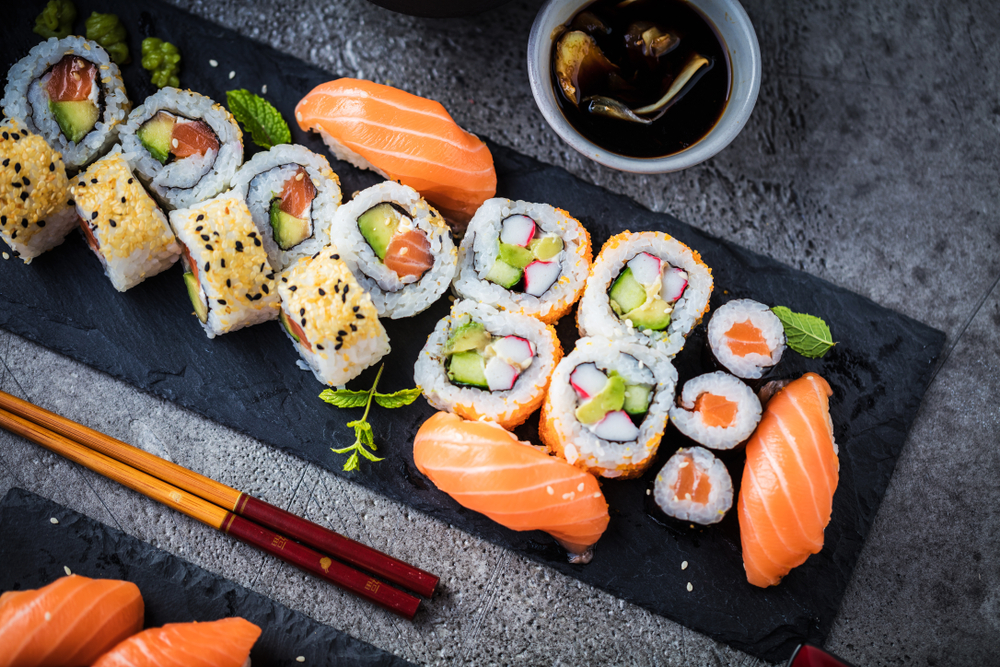As a sushi enthusiast, I know how disappointing it can be when your sushi bake loses its texture and flavor after being refrigerated.
Fortunately, there are ways to reheat sushi bake to restore its original taste and texture.
In this article, I will share with you some of the best methods to reheat sushi bake and ensure that it tastes just as good as when it was freshly made.
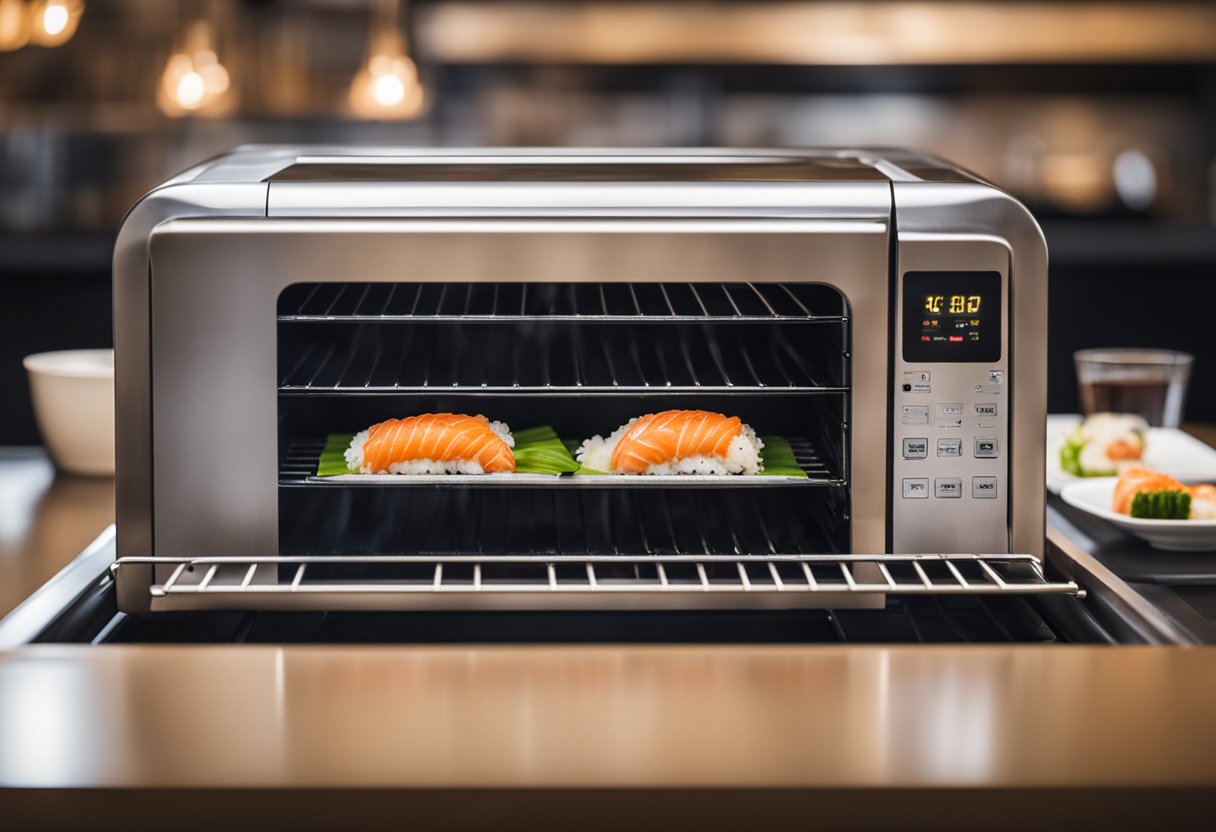
Before we dive into the different methods of reheating sushi bake, it’s important to understand what sushi bake is.
Sushi bake is a popular Filipino dish that consists of a layer of sushi rice topped with various ingredients such as crab meat, salmon, or shrimp, and then baked in the oven.
It’s a delicious and convenient way to enjoy sushi, but reheating it can be a bit tricky. In the next section, we’ll discuss some pre-reheating preparation tips that will help you ensure the best results when reheating your sushi bake.
Key Takeaways
- Sushi bake is a Filipino dish that consists of a layer of sushi rice topped with various ingredients and baked in the oven.
- Pre-reheating preparation is key to ensuring optimal texture and flavor when reheating sushi bake.
- There are different methods to reheat sushi bake, including oven and microwave methods, and it’s important to follow food safety guidelines when reheating and storing leftover sushi bake.
Understanding Sushi Bake

As a sushi lover, I am always on the lookout for new and exciting ways to enjoy this delicious cuisine.
One of my recent discoveries is sushi bake, a baked casserole dish that combines the flavors of sushi in a convenient, easy-to-prepare format.
In this section, I will explain the components of sushi bake and popular variations that you can try.
Components of Sushi Bake
Sushi bake typically consists of layers of rice, nori, and various toppings, all baked together in a casserole dish.
The rice is usually seasoned with vinegar and sugar, giving it a slightly sweet and tangy flavor that pairs well with the other ingredients. Nori, which is a type of seaweed, adds a subtle umami flavor and provides a crispy texture to the dish.
The toppings for sushi bake can vary widely depending on personal preference. Some popular options include fish, vegetables, imitation crab, cream cheese, and furikake, which is a Japanese seasoning made from dried fish, sesame seeds, and other ingredients.
Cheese is also a common addition to sushi bake, adding a creamy texture and rich flavor to the dish.
Popular Sushi Bake Variations
One of the great things about sushi bake is its versatility. There are countless variations of this dish, each with its own unique combination of flavors and ingredients.
Here are a few popular sushi bake variations that you might want to try:
- California Roll Sushi Bake: This variation includes imitation crab, avocado, cucumber, and cream cheese, all topped with a layer of spicy mayo and crunchy tempura bits.
- Spicy Tuna Sushi Bake: This variation features a layer of spicy tuna mixed with mayo and sriracha, topped with avocado and sesame seeds.
- Teriyaki Chicken Sushi Bake: This variation includes teriyaki chicken, bell peppers, and onions, all mixed together with rice and topped with a layer of melted cheese.
Overall, sushi bake is a delicious and convenient way to enjoy the flavors of sushi in a new and exciting format. With so many variations to choose from, you’re sure to find one that suits your tastes.
Pre-Reheating Preparation
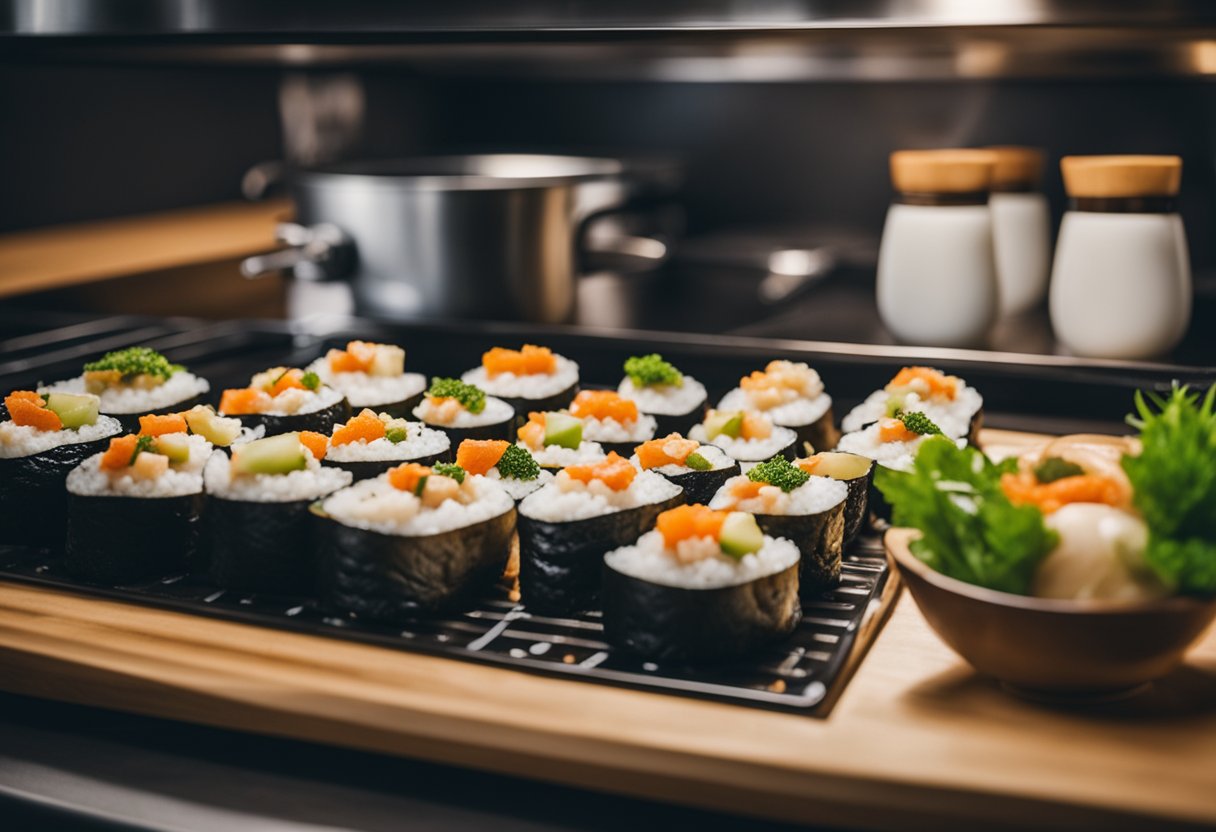
Before reheating your sushi bake, it’s important to prepare it properly to ensure that it reheats evenly and maintains its texture and flavor.
Here are a few things you should do before reheating your sushi bake:
Bringing Sushi Bake to Room Temperature
It’s important to bring your sushi bake to room temperature before reheating it. This will help ensure that it reheats evenly and that the center of the bake is not cold.
To bring your sushi bake to room temperature, take it out of the refrigerator and let it sit at room temperature for about 30 minutes before reheating it.
Preheating Your Reheating Appliance
Preheating your reheating appliance is crucial to ensure that your sushi bake reheats evenly and thoroughly. The reheating appliance can be an oven, toaster oven, microwave, or stovetop.
If you’re using an oven or toaster oven, preheat it to 350°F (175°C) before placing the sushi bake inside. If you’re using a microwave, make sure to set it to the appropriate power level and time according to the manufacturer’s instructions.
It’s also important to use an airtight container to store your sushi bake in the refrigerator before reheating it.
This will help prevent it from drying out and losing its texture and flavor. Make sure to only reheat your sushi bake once to avoid overcooking it and compromising its quality.
By following these simple steps, you can ensure that your sushi bake reheats evenly and maintains its delicious flavor and texture.
Reheating Methods
When it comes to reheating sushi bake, there are a few methods you can choose from. The most popular ones are the oven method, microwave method, and stovetop method.
Each method has its own advantages and disadvantages, so it’s important to choose the one that works best for you.
Oven Reheating Method
The oven method is the most common way of reheating sushi bake. It’s also the best option if you want to restore the original taste and texture of the dish.
Here’s how to do it:
- Preheat your oven to 350 degrees Fahrenheit.
- Place the sushi bake in an oven-safe dish or casserole.
- Cover the dish with aluminum foil to prevent it from drying out.
- Bake for about 15-20 minutes or until the internal temperature of the sushi bake reaches 165 degrees Fahrenheit.
- Remove from the oven and let it cool slightly before serving.
Microwave Reheating Method
The microwave method is the quickest and easiest way to reheat sushi bake. However, it may not produce the same texture and taste as the oven method.
Here’s how to do it:
- Transfer the desired amount of leftover sushi bake to a microwave-safe dish.
- Cover the dish with a microwave-safe lid or plastic wrap, leaving a small vent for steam to escape.
- Microwave on high for 30-60 seconds or until the sushi bake is heated through.
- Stir the sushi bake and check the internal temperature with a food thermometer to ensure it has reached 165 degrees Fahrenheit.
- Let it cool slightly before serving.
Stovetop Reheating Method
The stovetop method is a good option if you don’t have access to an oven or microwave. You can use a skillet or pot to reheat sushi bake on the stove.
Here’s how to do it:
- Heat a skillet or pot over medium heat.
- Add a small amount of oil or water to the skillet or pot.
- Add the sushi bake to the skillet or pot and cover with a lid.
- Cook for 5-10 minutes or until the sushi bake is heated through.
- Stir the sushi bake occasionally and check the internal temperature with a food thermometer to ensure it has reached 165 degrees Fahrenheit.
- Let it cool slightly before serving.
In conclusion, reheating sushi bake is easy and can be done using different methods. Whether you choose to reheat sushi bake in the oven, microwave, or stovetop, make sure to check the internal temperature with a food thermometer to ensure it has reached 165 degrees Fahrenheit.
Ensuring Optimal Texture and Flavor
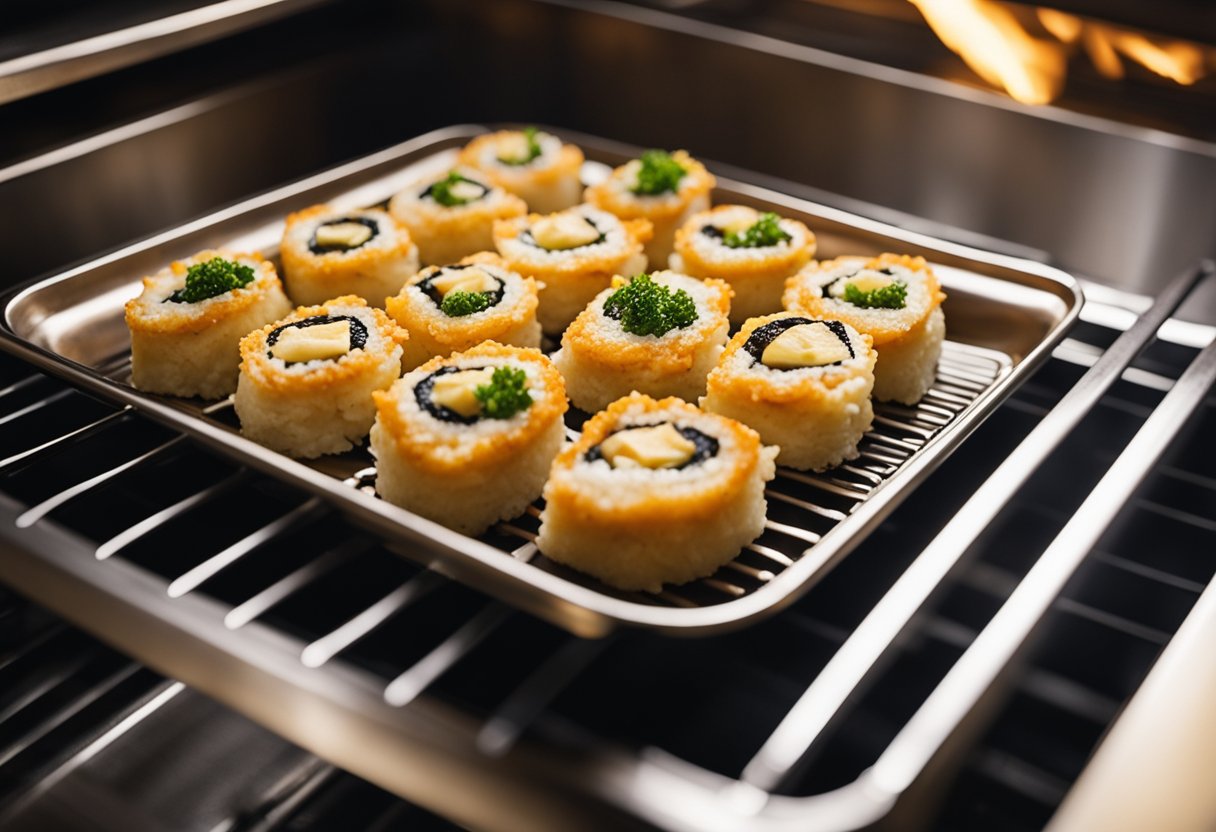
As a sushi enthusiast, I know how important it is to reheat sushi bake the right way to ensure that it retains its optimal texture and flavor.
Here are some tips that I have found to be helpful:
Avoiding Overcooking
Overcooking sushi bake can ruin its texture and make it dry and chewy. To avoid overcooking, I recommend using an oven or toaster oven instead of a microwave. Microwaves can heat unevenly and cause the rice to become hard and rubbery.
Retaining Moisture
Retaining moisture is key to keeping sushi bake fresh and delicious. To retain moisture, I suggest covering the dish with aluminum foil or plastic wrap before reheating it. This will trap the steam and keep the rice and seafood moist.
Adding Fresh Garnishes
Adding fresh garnishes is a great way to enhance the flavor of sushi bake. Sliced green onions, toasted sesame seeds, and a squeeze of lemon juice can add a burst of freshness and acidity that complements the rich flavors of the dish.
In summary, by avoiding overcooking, retaining moisture, and adding fresh garnishes, you can ensure that your reheated sushi bake maintains its optimal texture and flavor.
Food Safety and Storage
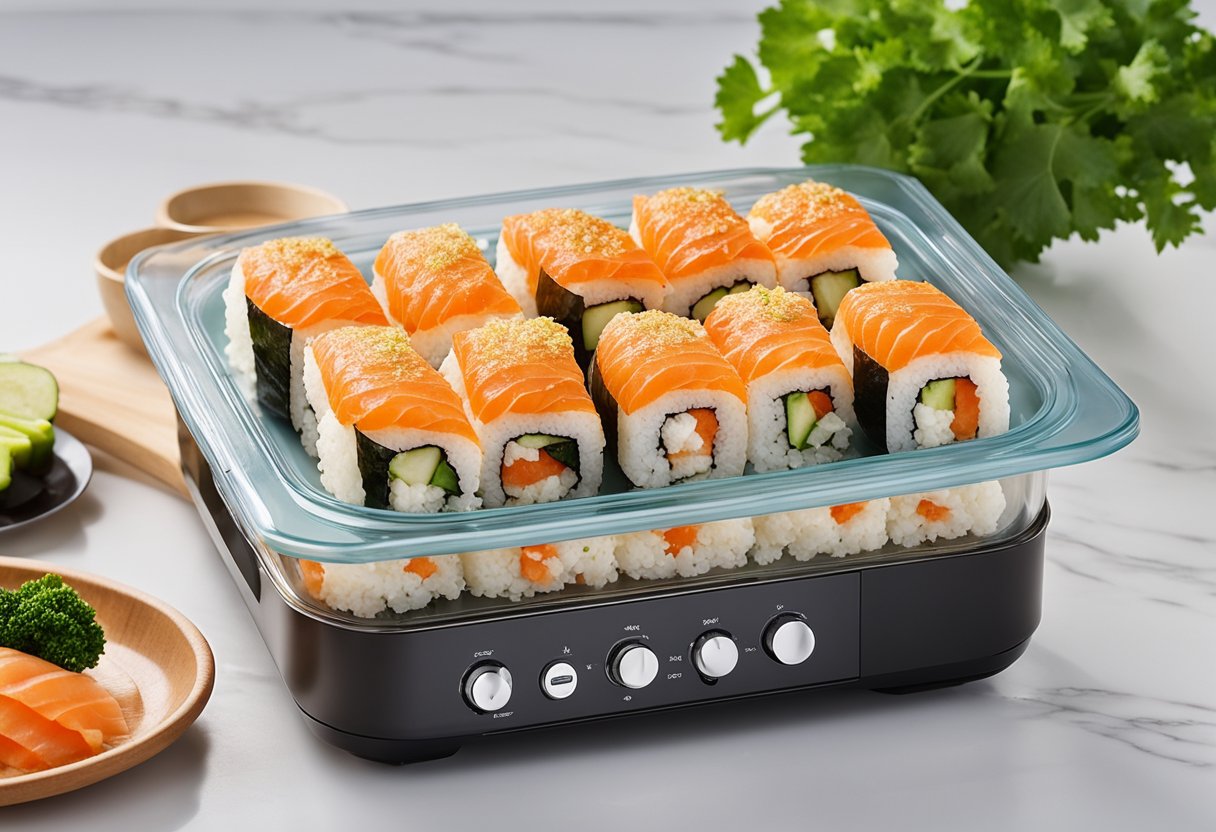
As with any food, it is important to follow proper food safety and storage techniques when handling leftover sushi bake.
This will help to ensure that the food remains safe to eat and does not spoil. In this section, I will discuss some tips for properly storing and recognizing when sushi bake is no longer safe to eat.
Proper Storage Techniques
One of the most important things to keep in mind when storing leftover sushi bake is to make sure it is stored in an airtight container.
This will help to prevent the food from drying out and will also prevent any bacteria or other contaminants from getting in. It is also important to store the sushi bake in the refrigerator as soon as possible after it has been cooked.
When storing leftover sushi bake, it is important to keep it separate from other foods, especially raw fish. This will help to prevent any cross-contamination and will also help to keep the sushi bake fresh for longer.
If you are storing the sushi bake for more than a day, it is also a good idea to label the container with the date that it was cooked so that you can keep track of how long it has been stored.
Recognizing When Sushi Bake Is No Longer Safe to Eat
Even with proper storage techniques, there may come a time when leftover sushi bake is no longer safe to eat.
Some signs that the sushi bake may have spoiled include a foul odor, a slimy texture, or mold growth. If you notice any of these signs, it is best to err on the side of caution and throw the sushi bake away.
Another thing to keep in mind is that leftover sushi bake should not be reheated more than once. This can increase the risk of bacterial growth and can also alter the texture and flavor of the food.
If you have leftover sushi bake that you do not plan on eating, it is best to freeze it rather than trying to reheat it again.
By following these tips for proper storage and recognizing when sushi bake is no longer safe to eat, you can help to ensure that your food remains fresh and safe to eat.
Related post: Can You Microwave Sushi
Frequently Asked Questions
What is the best method to reheat sushi bake to maintain its flavor?
The best method to reheat sushi bake while maintaining its flavor is to use an oven or toaster oven.
According to Sushi Enthusiast, preheating the oven to 350°F (175°C) and placing the sushi bake in an oven-safe dish covered with aluminum foil will ensure even reheating without compromising taste or texture.
Bake for about 15-20 minutes or until the sushi bake is heated through. It is not recommended to reheat sushi bake in a microwave, as it can make the rice hard and the texture rubbery.
Can you reheat a sushi bake in the microwave, and if so, how?
While reheating sushi bake in a microwave is a quick and easy option, it is not the best method to maintain its flavor and texture.
However, if you must use a microwave, Loving Hut Falls Church recommends placing the sushi bake in a microwave-safe dish and covering it with a damp paper towel.
Microwave for about 30 seconds to 1 minute on medium heat, checking frequently to avoid overcooking.
What precautions should be taken when reheating sushi bake with seafood such as salmon or shrimp?
Seafood such as salmon or shrimp can be added to sushi bake to enhance its flavor. However, it is important to take precautions when reheating sushi bake with seafood to avoid overcooking the seafood.
Reheated.org suggests covering the sushi bake with aluminum foil to prevent it from drying out and baking it for about 15-20 minutes at 350°F (175°C).
It is recommended to check the internal temperature of the seafood with a meat thermometer to ensure it is cooked to the appropriate temperature.
Is it safe to eat sushi bake after refrigeration, and how does refrigeration time affect it?
Sushi bake can be refrigerated for up to 3 days. The Fork Bite recommends storing sushi bake in an airtight container in the refrigerator.
However, the longer sushi bake is refrigerated, the more its quality deteriorates. It is recommended to reheat sushi bake within 24 hours of refrigeration to maintain its texture and flavor.
What are the signs that sushi bake has gone bad and should not be reheated?
Sushi bake that has gone bad should not be reheated or consumed. Signs that sushi bake has gone bad include a sour smell, slimy texture, or the presence of mold.
Reheated.org recommends discarding sushi bake that has been left unrefrigerated for more than 2 hours or refrigerated for more than 3 days.
How can you ensure that a vegetarian sushi bake retains its quality when reheated?
Vegetarian sushi bake can be reheated using the same methods as regular sushi bake. However, it is important to ensure that the vegetables used in the sushi bake are not overcooked.
Sushi Enthusiast recommends checking the internal temperature of the sushi bake with a meat thermometer to ensure it is heated through without overcooking the vegetables.



